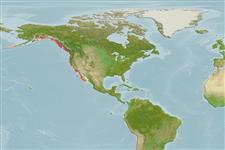>
Perciformes/Zoarcoidei (Eelpouts and pricklebacks) >
Opisthocentridae ("Rearspined fin pricklebacks")
Etymology: Lumpenopsis: Latin, lumpus, an uncouthlooking spiny-finned fish of a leaden-blue colour + Greek, opsis = appearance (Ref. 45335).
More on authors: Hubbs & Schultz.
Environment: milieu / climate zone / depth range / distribution range
पारिस्थितिकी
समुद्री बेनथोपिलाजिक; गहराई सीमा 30 - 100 m (Ref. 51666). Temperate
Eastern Pacific: southern British Columbia, Canada to California, USA.
आकार / वज़न / Age
Maturity: Lm ? range ? - ? cm
Max length : 7.6 cm TL पुल्लिंग / अलिंग; (Ref. 2850)
Short description
पहचान कुंजी | आकृति विज्ञान | मौरफोमैटरिक्स
पृष्ठीय रीढ़ (सम्पूर्ण) : 44; गुदा कांटा: 1; ऐनल सौफट रेज़: 31. Caudal oval; pectorals large, pointed (Ref. 6885).
Found in sandy to rocky bottoms (Ref. 51666).
Life cycle and mating behavior
परिपक्व अवधि | पुनरुत्पत्ति | मछलीऔ का अंडे देना | अंडे | Fecundity | लार्वा
Eschmeyer, W.N., E.S. Herald and H. Hammann, 1983. A field guide to Pacific coast fishes of North America. Boston (MA, USA): Houghton Mifflin Company. xii+336 p. (Ref. 2850)
IUCN Red List Status (Ref. 130435: Version 2024-2)
Threat to humans
Harmless
Human uses
साधन
Special reports
Download XML
इंटरनेट स्रोत
Estimates based on models
Preferred temperature (Ref.
123201): 8 - 11.8, mean 8.7 °C (based on 11 cells).
Phylogenetic diversity index (Ref.
82804): PD
50 = 0.5625 [Uniqueness, from 0.5 = low to 2.0 = high].
Bayesian length-weight: a=0.00102 (0.00046 - 0.00225), b=3.06 (2.88 - 3.24), in cm total length, based on all LWR estimates for this body shape (Ref.
93245).
Trophic level (Ref.
69278): 3.0 ±0.00 se; based on food items.
Fishing Vulnerability (Ref.
59153): Low vulnerability (10 of 100).
